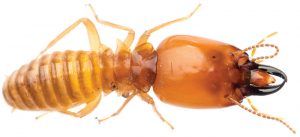Mosquitoes may have stolen all the headlines this year, thanks to non-stop worldwide coverage of the Zika virus. But in the U.S., pest management professionals (PMPs) are still cashing in the most on ants — specifically carpenter ants, which technically also count as wood-destroying insects (WDI).
This year, carpenter ants beat out pavement ants and odorous house ants (OHA) as top species, according to Pest Management Professional‘s (PMP) 2017 State of the Industry Survey. Last year, OHA played the ace, with carpenter ants taking the No. 2 slot and pavement ants as No. 3.
Ant expert and 2015 PMP Hall of Famer Dr. Laurel Hansen, biology instructor at Spokane Falls (Wash.) Community College, says one reason for the difference in number year to year is a matter of identification: Pavement ants (Tetramorium caespitum) are often mistaken for OHA (Tapinoma sessile), and vice versa.
“The surveys are always interesting, because the areas surveyed do change annually, as do the weather patterns, which can be another factor,” she adds.
Rodent influx
Survey respondent Rich Smith, manager of Smithereen Pest Management’s Greater Chicago branch, says Norway rats have become a developing problem for Chicago suburbs in a way not seen before.
“It used to be that downtown Chicago and its collar suburbs would have problems, but not the outlying areas,” he tells PMP. “But now we’re getting a lot more calls.”
The main concentration of the rodent influx is in shopping malls and other retail areas, Smith says, particularly around outdoor food courts, dumpsters and adjacent refuse areas.
“We theorize it might be the way the garbage service process has evolved,” he says. “When they change out the compactor to bring the full compactor back to the transfer stations, they might be inadvertently introducing a population.”
Besides, he says, areas near dumpsters offer excellent conditions for rodent burrows.
Talk about the weather
In addition to sanitation practices, weather extremes also can have a direct effect on pest pressure. For example, this year has seen a lot of flooding in the U.S., particularly in Louisiana and other parts of the Southeast.
“You might think all the water would have negative effects on ground-nesting pests like ants and termites, but they just go deeper into the ground and higher into structures and trees,” says Dr. Gary Bennett, a 2006 PMP Hall of Famer and coordinator of Purdue University’s Urban and Industrial Pest Management Center in West Lafayette, Ind.
Dr. Bennett is a Louisiana native who worked at his father’s company, Bennett Pest Control, for several years before going into academia. He notes that many insects have ways to adjust to natural disasters.
“Fire ants actually form into floating balls of ants that can be seen on top of flood waters until the water recedes, and outdoor species of cockroaches always are able to find harborage in above-ground, protected areas,” he offers. Because of this, he adds, “their numbers may actually be spread or increased in structures as a result of flooding.”
Their numbers may be culled a bit initially after a disaster, Dr. Bennett asserts, but in the long-term these pests “do just fine” — especially in the aftermath of a flood, where debris provides additional food and harborage opportunities.
In Southern California, the long drought is affecting pest pressure. Dr. Mike Rust, a distinguished professor of entomology at the University of California, Riverside, and a 2007 PMP Hall of Famer, says this summer has been an exceptionally bad one for Argentine ants (Linepithema humile).
“I am also still seeing outdoor populations of Turkestan cockroaches, but our studies suggest this is an arid adapted species,” he says, noting that in mid-September, there were some scattered rains and “local termites were swarming.”
But just like pests, humans are starting to adapt, too.
“As a result of the continuing drought and water shortages, many residents have removed lawns and converted to more arid landscapes around structures,” Dr. Rust says. “This will have an impact on the species around structures. This was noticed by Dr. Les Greenberg and some of the lab helpers in our ant project in Riverside.”
Mosquito madness
Dr. Phil Koehler, a 2015 PMP Hall of Famer and endowed urban entomology professor for the University of Florida in Gainesville, has been heavily involved in the state’s evolving response to the Zika virus issue.
“Before endemic mosquito transmission of Zika occurred in Florida, we at the University of Florida trained the pest control industry to partner with mosquito districts to control the Zika vectors,” he explains. “Because Zika vectors develop in containers, fly short distances and are daytime biters, we worked with the industry to apply residual treatments to vegetation and structures using mist blowers.”
As soon as Zika transmission was confirmed, Dr. Koehler says, officials from Florida and from Atlanta’s U.S. Centers for Disease Control and Prevention (CDC) decided the most appropriate response was a mix of aerial and ground treatments.
“The pest control industry was placed in a position of backup in case their treatments were needed,” he says. “We have data to show, however, that the residual treatments to vegetation can provide eight weeks of nearly 100 percent control.”
While he doesn’t have safety concerns over this current approach, Dr. Koehler says he hopes authorities will consider integrating more targeted treatments.
“There is a thought that mosquitoes need to be controlled by mosquito districts using space sprays. That may be true for saltmarsh and everglades mosquitoes, but the ones that develop in people’s yards should be controlled with residual treatments targeted to the areas where they rest,” he says. “The pest control industry is best positioned to provide those treatments. They have the people, the equipment, and the ability to deliver the treatments in the most effective manner.”
While a dry summer in Chicagoland actually made for less mosquito pressure, Smithereen’s Smith reports his techs were still made aware of the health risks posed by mosquito-borne diseases like the Zika and West Nile viruses. Education helps enable them to allay fears of their customers, he says, and adds to the professionalism of the industry.
“I believe that the public is beginning to perceive our industry as being comprised of professionals who solve real problems,” Smith concludes. “In Florida, it’s almost a given that a homeowner has pest management service, for example, but in the Midwest it’s seen as more of either a luxury or an emergency service. Now, as people are starting to see a legitimate connection between pests and public health, that’s beginning to change.”
Top 5 Managed Mosquitoes
- Asian tiger mosquito
- Southern house mosquito
- Northern house mosquito
- Yellow fever mosquito
- Other mosquito species
Most-Managed Ants
- Carpenter ants
- Pavement ants
- Odorous house ants
- Argentine ants
- Fire ants
- Pharaoh ants
- Bigheaded ants
- Ghost ants
- Tawny crazy ants
Most-Managed Nuisance Birds
- Pigeons
- Starlings
- House sparrows
- Crows
- Geese
- Grackles
- Barn swallows
- Seagulls
- Turkey vultures
Most-Managed Cockroaches
- German cockroaches
- American cockroaches
- Oriental cockroaches
- Smokey brown cockroaches
- Brownbanded cockroaches
- Australian cockroaches
- Asian cockroaches
- Turkistan cockroaches
- Florida woods cockroaches
Most-Managed Fleas & Ticks
- Cat fleas
- American dog ticks
- Brown dog ticks
- Deer ticks
- Oriental rat fleas
- Rocky Mountain wood ticks
- Lone Star ticks
- Gulf Coast ticks
- Other flea and tick species
Most-Managed Flies
- House flies
- Fruit flies
- Drain flies
- Small flies
- Fungus gnats and phorid flies (tie)
- Cluster flies
- Bottle and blow flies (tie)
- Stable flies
- Complex flies
Most-Managed Rodents
- House mice
- Norway rats
- Roof rats
- Deer mice
- Moles
- Meadow mice
- Voles
- Hallway rats
- Other rodent species
Most-Managed Spiders
- American house and wolf spiders (tie)
- Cellar spiders
- Black widow spiders
- Brown recluse spiders
- Grass spiders
- Yellow sac spiders
- Brown widow spiders
- Aggressive house spiders
- Mediterranean recluse spiders
Most-Managed Wood Destroying Insects/Organisms (WDI/WDO)
- Eastern subterranean termites
- Carpenter ants
- Carpenter bees
- Wood-decay fungi and True powderpost beetles (tie)
- Drywood termites
- Western subterranean termites
- Old house borers
- Formosan termites
- Other termites and WDI/WDO species
Most-Managed Stinging Insects
- Common paper wasps
- Yellowjackets
- Honeybees
- Mad dauber wasps
- Bumblebees
- Cicada killer wasps
- Mediterranean paper wasps
- Bark scorpions
- Africanized honeybees
Most-Managed Stored Product Pests
- Indianmeal moths
- Drugstore beetles
- Sawtoothed grain beetles
- Confused flour beetles
- Cigarette beetles
- Red flour beetles
- Rice and granary weevils (tie)
- Dermestid beetles
- Merchant grain beetles
Editor Heather Gooch can be reached at hgooch@northcoastmedia.net or 330-321-9754.
Feature photo: iStock/edelmar








Leave A Comment